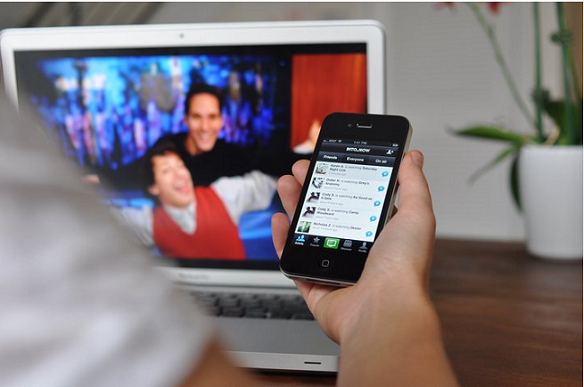Article 40: Yahoo Buys TV Chatting Technology
April 25, 2011 Source: NY Times
By VERNE G. KOPYTOFF Friends inevitably dissect their favorite television shows when they are out together. When online, they often do much the same by posting messages on Facebook or Twitter.
Friends inevitably dissect their favorite television shows when they are out together. When online, they often do much the same by posting messages on Facebook or Twitter.
Hoping to capitalize on television’s central role in TV chit chat, Yahoo said on Monday that it bought IntoNow, a mobile phone app that lets users tell friends what they are watching and discuss it. The idea is to create a social experience around television, even if a person is watching a show alone. Yahoo did not disclose the price for the company.
What sets IntoNow apart is its ability to automatically recognize shows. Users let the app listen to a show for a few seconds, and, in theory, it will determine the name of the program and the episode.
IntoNow has a vast database of shows over the last five years – the equivalent of 266 years of programming. The app can also detect new programs on 130 channels.
After the app recognizes “Desperate Housewives,” for instance, users can then share that information without having to type it in on their mobile phones. The same goes for news programs like CNN.
“Relying on social channels as a means for discovering content – whether it’s on a PC, mobile device or TV – is rapidly on the rise,” Bill Shaughnessy, senior vice president of product management and product marketing at Yahoo, said in a press release. “IntoNow’s technology combines the ability to check-in to what a consumer is watching, engage in conversations, and find related content.”
Yahoo said that the technology may be used across the Yahoo portal, including in video search and mobile. The app may also be useful in some way for advertisements, which users may want to share.
However, while IntoNow can detect national shows, it is less effective with local programming or live sporting events. The app is available only for iPhone, although the IntoNow team said in a blog post on Monday that the acquisition would help it with building apps for Android and iPad.
GetGlue and Miso are rival television check-in apps, although they do not have audio detection capabilities.
Yahoo’s track record with acquisitions is not exactly stellar. A number of the company’s acquisitions have either been shut down or failed to make much of a splash beyond the initial announcement, like Maven Networks, an online video platform that closed in 2009, and MyBlogLog, a service for blog owners that is set to close next month.
In financial funk, Yahoo is trying to revive its business and enhance its appeal to users who may otherwise spend more time on Facebook. Carol A. Bartz, Yahoo’s chief executive, has said, however, that her turnaround plan will take some time. She took over Yahoo two years ago.
Yahoo announced first quarter earnings last week that showed promising signs in the company’s main business — display advertising — but troubles in search.
 Someone chatting about the TV show using IntoNow.
Someone chatting about the TV show using IntoNow.
Class Tie-In
This article and its content involves many terms we discussed such as: social media, business-to-business markets, and even product line extensions. With Yahoo purchasing IntoNow this blended the two businesses into one goal: having more customers attracted to Yahoo. With its new aquistion Yahoo hopes to have more of the general public searching and spending time on Yahoo. With this new social media ploy, the company will certianly attract more people. This give people an opportunity to achieve more utility while watching TV shows because they can talk to their friends about them through this product. I mentioned product line extension because Yahoo is extending their product in new ways. Typically, people use Yahoo for mail, search engines, or news articles, but now Yahoo is extending its product and brand to include social media.



 Netflix CEO Reed Hastings has presided over a decade of soaring growth at his video streaming and rental company.
Netflix CEO Reed Hastings has presided over a decade of soaring growth at his video streaming and rental company. 






